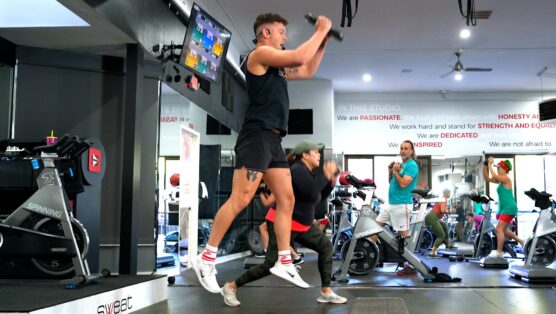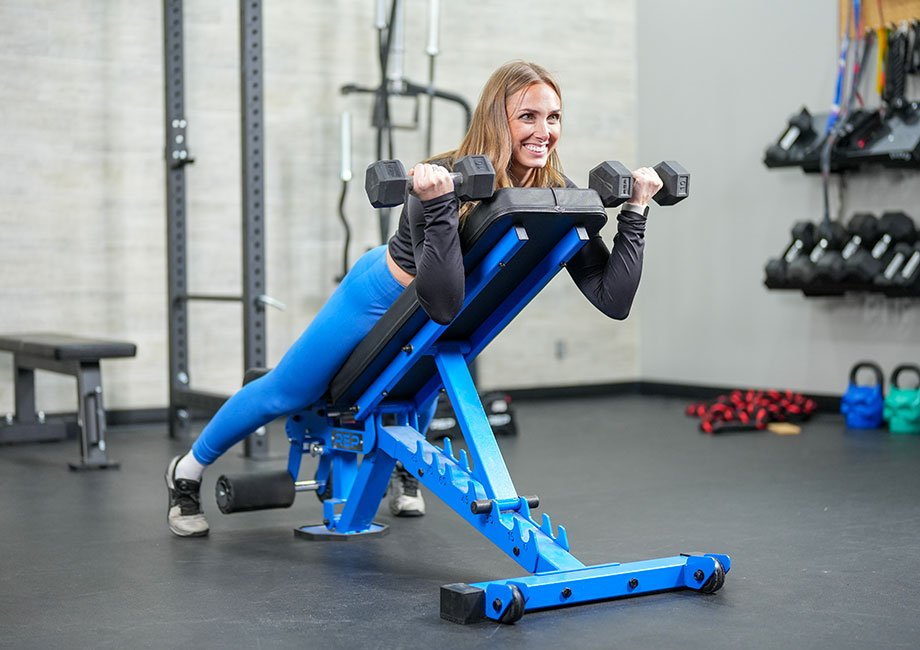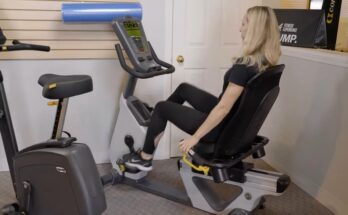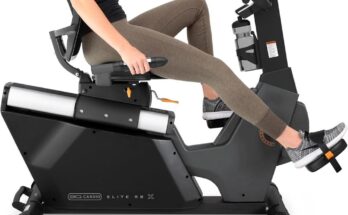Yes, you can build muscle on a recumbent bike primarily in the lower body. It’s an effective workout for strengthening leg and glute muscles.
A recumbent bike is a smart choice for those aiming to enhance muscle tone without the impact of more intense exercises like running. It is particularly favored among fitness enthusiasts who require a low-impact exercise option, yet still want to engage in a muscle-building workout regimen.
The bike’s design supports the back, allowing for a comfortable fitness experience while targeting the quadriceps, hamstrings, calves, and glutes. Regular sessions on this piece of gym equipment can help improve muscle endurance and strength over time, making it a valuable tool for achieving muscle growth. Beginners and those with joint concerns find the recumbent bike an excellent way to safely build lower body muscles.
Myth-busting: Muscle Building On A Recumbent Bike
Ideal for comfort and low-impact workouts, the recumbent bike is a staple in gyms and homes. But does it have what it takes to build muscle? It’s time to separate fact from fiction, as we delve into muscle building potential on a recumbent bike.
Debunking Common Misconceptions
Many believe that recumbent bikes lack the intensity for muscle growth. Let’s bust this myth:
- Resistance is key – Cranking up the resistance on a recumbent bike can indeed challenge your muscles, similar to uphill cycling.
- Lower body gains – With the right resistance, your legs and glutes can experience significant strengthening and toning.
- Recumbent cycling can complement strength training routines. Think of it as a part of a diversified workout strategy.
Recumbent Bike Basics
Understanding the mechanics of a recumbent bike is vital for muscle building:
| Feature | Benefit |
|---|---|
| Seated Position | Supports your back and reduces the risk of strain. |
| Pedal Placement | Engages lower body muscles differently than upright bikes. |
| Adjustable Resistance | Allows for progressive muscle challenge over time. |
By understanding the essentials and applying varied resistance, the recumbent bike can be a muscle-building tool in your fitness arsenal. Let the pedaling begin!

Credit: totendurance.com
Recumbent Bike Vs. Upright Bike: A Comparative Analysis
Choosing between a recumbent bike and an upright bike can be tricky. Each offers unique benefits. This analysis delves into muscle engagement and joint health. The aim is to help you pick the right bike for muscle building.
Muscle Engagement DifferencesMuscle Engagement Differences
Recumbent bikes support your back. They let you target lower body muscles differently. Upright bikes simulate a traditional cycling position. This engages your upper body more. Here’s how they compare:
- Recumbent Bike: Focuses on hamstrings and glutes.
- Upright Bike: Works on abdominals and arms too.
You engage your core on upright bikes. You build better overall muscle tone.
Impact on Joint HealthImpact On Joint Health
Comfort is key with recumbent bikes. They are gentle on joints. Upright bikes can stress your joints more. Here’s a comparison:
| Recumbent Bike | Upright Bike |
|---|---|
| Less strain on hips and knees | More similar to regular cycling |
| Great for injury recovery | Can increase muscle and joint stress |
Recumbent bikes are ideal for those with joint issues. Upright bikes can boost muscle strengthening. It’s vital to choose based on your health needs.
Essential Strategies To Maximize Muscle Gain
Want to beef up your muscles using a recumbent bike? Great choice! Recumbent bikes are more than just comfy seats for pedaling; they’re powerful tools for building muscle. The key lies in the right strategies. Let’s explore how to squeeze every bit of muscle-building potential out of your recumbent bike workouts.
Adjusting Resistance And Intensity
To crank up muscle growth, tweaking resistance and intensity is crucial. Here’s how:
- Start slow and warm up your muscles.
- Gradually increase the resistance to challenge your legs.
- Focus on pumping harder during each session to build strength.
- Include high-resistance sprints to bring your muscles to fatigue.
- Give muscles time to recover between sessions.
Incorporating Interval Training
Interval training pushes your muscles and endurance. It mixes high-intensity bursts with rest periods. This can foster faster muscle gain on your recumbent bike. Consider:
- Switching between one minute of hard pedaling and two minutes of lighter cycling.
- Repeating this pattern for at least 20 to 30 minutes.
- Tracking your progress and adjusting intervals as you get stronger.
Stick to these strategies, and you’ll be on track to build muscle with your recumbent bike. Pump up the resistance, add some intervals, and see the transformation!

Credit: m.facebook.com
Diet And Nutrition For Recumbent Riders
When cycling on a recumbent bike, building muscle goes beyond just exercise. A proper diet fuels your workouts and aids muscle recovery. Recumbent riders need a balanced diet rich in key nutrients to enhance performance.
Optimizing Protein Intake
Protein is vital for muscle repair and growth. Integrating high-quality protein sources into your diet is essential.
- Lean meats – chicken, turkey, and fish
- Dairy products – milk, yogurt, and cheese
- Plant-based proteins – beans, lentils, and tofu
Aim for 1.2 to 2.0 grams of protein per kilogram of body weight daily.
Hydration And Its Muscle-building Role
Muscles need water to function properly. Staying hydrated boosts muscle strength and endurance.
| Time | Hydration Tip |
|---|---|
| Before Workout | Drink 17-20 ounces of water |
| During Workout | Sip 7-10 ounces every 10-20 minutes |
| After Workout | Rehydrate with 16-24 ounces per pound lost |
Use these guidelines to maintain optimal hydration levels.
Complementary Exercises For Recumbent Bikers
Cycling on a recumbent bike gets your legs moving and heart pumping. But what about the rest of your body? Complementing your rides with targeted exercises can build muscle and flexibility.
Strength Training Workouts
To build muscle, include strength training in your routine. Pair recumbent biking with these workouts:
- Squats: They strengthen your legs and glutes. Perfect for pedaling power.
- Deadlifts: Work your back, glutes, and hamstrings. Better posture on the bike.
- Bench Press: Build a strong chest, shoulders, and arms. Hold cycling posture easily.
Remember to rest between strength sessions. Muscles grow when resting.
Flexibility And Core-strengthening Moves
A flexible body and solid core enhance your cycling. Try these moves:
- Stretching: Reach down to your toes. Loosen those tight leg muscles.
- Yoga: Poses like Downward Dog extend your flexibility. Hold the handlebars comfortably.
- Planks: A staple for core strength. Sit straight, cycle better.
Include these exercises regularly for best results. Recumbent bikers can enjoy a full-body workout!
Real Riders’ Success Stories: Building Muscle On Recumbent Bikes
Think recumbent bikes are just for leisurely riding? Think again! Real riders are using these low-impact machines to build impressive muscle strength. Discover how pedaling on a recumbent bike can indeed lead to real gains in muscle and fitness.
Personal Journeys
From The Experts: Trainers’ Insights
Trainers highlight muscle gains on recumbent bikes. They praise the bike’s design for targeting lower body muscles like quads, hamstrings, and glutes.
| Expert | Top Benefit | Recommended Routine |
|---|---|---|
| Lisa, Fitness Coach | Improves joint health | 30 minutes, varied resistance |
| Mark, Personal Trainer | Builds lower body strength | 20-minute intervals, high intensity |
| Emily, Rehab Specialist | Enhances muscle stability | 45 minutes, steady pace |

Credit: www.studiosweatondemand.com
Frequently Asked Questions Of Can You Build Muscle On A Recumbent Bike?
Can Recumbent Bikes Tone Your Muscles?
Recumbent bikes are an effective tool for toning muscles, especially in the lower body. They engage the quadriceps, hamstrings, calves, and glutes during workouts, helping to build muscle endurance and strength over time with regular use.
Are Recumbent Bikes Effective For Bodybuilding?
While recumbent bikes can contribute to a toned physique, they are not typically used for bodybuilding. They’re better suited for cardiovascular workouts and muscle endurance rather than significant muscle mass increase.
How Often Should I Use A Recumbent Bike To Build Muscle?
For muscle building, aim to use a recumbent bike 3 to 5 times a week. Incorporate interval training and increase resistance levels gradually to challenge your muscles and promote growth.
Is A Recumbent Bike Better For Muscle Gain Than Upright Bikes?
Recumbent bikes provide a different muscle engagement compared to upright bikes, focusing more on the hamstrings and glutes. However, neither bike is superior for muscle gain; it depends on workout intensity and resistance used.
Conclusion
Building muscle on a recumbent bike is indeed possible. With consistent training and proper resistance levels, you can stimulate muscle growth, especially in your lower body. Don’t underestimate the power of cycling reclined; give it a try and see the gains for yourself! Commit to your fitness journey, and enjoy the ride to stronger, leaner muscles.



